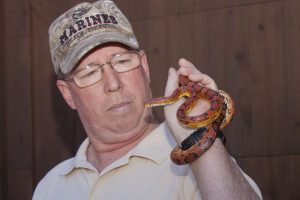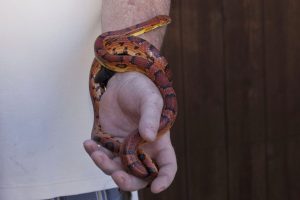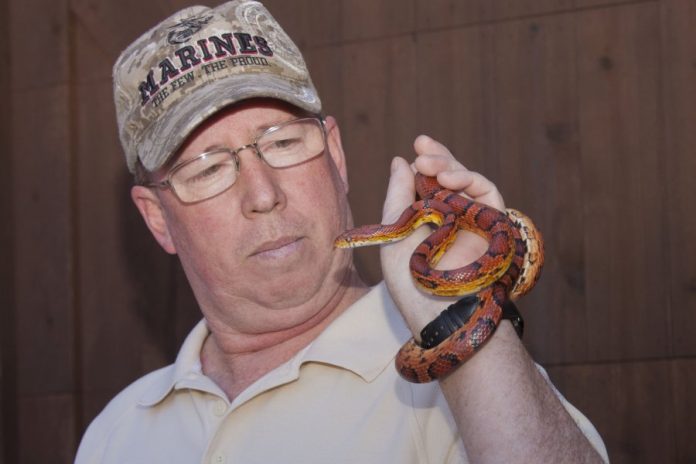
“Snakes around here don’t hibernate, they brumate” said Rob Boles, well-known “snake whisperer” of Lantana. “When it gets warm enough they will come out to bask in the sun and search for food. With the warm winter we had this year, I’ve had calls in December, January, and February.”
He said he’s seen people posting identification questions on general social media sites, but the best place to post a photo or question to get an expert answer is: facebook.com/groups/whatsnakeisthis. The free group has more than 37,000 members.
His best advice to minimize snakes taking up residence in your yard is to clean-up the property; keep the grass height under control, shrubbery clean without too much mulch, plants trimmed up, and good pest control.
“Snakes are there looking for a food source,” Boles said. “Contrary to the old moniker “the only good snake is a bad snake”, all snakes have a place in balancing the ecosystem.”
He told about an encounter with a Copperhead last year. A woman had called him about the snake that would cross her yard every night; always about 9 o’clock to go into the yard of the neighbor next door.
Boles looked over her fence and saw the neighbor’s yard had high grass and messy shrubs and various kinds of debris scattered everywhere; perfect for mice, rats or other “snake food.”
“She’d practically covered her yard with moth balls—my eyes were stinging from them—as a deterrent against snakes. People! There’s no such thing; a snake will go where a snake wants to go. In fact, under some circumstances, using mothballs outside can be a federal crime—don’t do it! The only thing the so-called “snake repellents” do well is separate you from your money.”
Boles said that a good 70-percent of the calls he gets are for Copperheads, with rat snakes coming in second.
His best advice is to stay away from any snake you find. You can outrun most snakes so just move away and let the snake go its way. He added that parents should educate their children about snakes in the same way they do with stranger warnings and fire or tornado drills.

“Think ‘stranger danger,’” said Boles. “Snakes don’t normally strike unless they’re provoked, cornered, feel threatened (think pets), or injured. And contrary to some beliefs snakes don’t attack or chase humans, if they are coming towards you it’s because they either have no other way to go or you’re between it and its home or somewhere else it feels safe. People get bit when they try to catch or kill a snake.”
He said that while most venomous snakebites won’t kill an adult, everyone reacts differently and there might be an allergic reaction to the venom.
“Don’t take a chance,” Boles advised. “Try to remain calm and get medical help as soon as possible.”
Boles said he was raised “a country kid” and has always been around snakes. As he got older, he became fascinated by them and has respect for them.
“This [responding to snake calls] isn’t a business to me,” he said. “It’s a service I’m glad to do.”
If you encounter a snake and want it relocated Boles may be reached at: 972-317-5853.
Snake Bites Do’s and Don’ts
Here’s some helpful advice from the Mayo Clinic that we hope you never need: If you are bitten by a venomous snake, call 911 or your local emergency number immediately, especially if the area changes color, begins to swell or is painful. Many hospitals stock anti-venom drugs, which may help you.
If possible, take these steps while waiting for medical help:
- Remain calm and move beyond the snake’s striking distance.
- Remove jewelry and tight clothing before you start to swell.
- Position yourself, if possible, so that the bite is at or below the level of your heart.
- Clean the wound, but don’t flush it with water. Cover it with a clean, dry dressing.
Caution:
- Don’t use a tourniquet or apply ice.
- Don’t cut the wound or attempt to remove the venom.
- Don’t drink caffeine or alcohol, which could speed the rate at which your body absorbs venom.
- Don’t try to capture the snake. Try to remember its color and shape so that you can describe it, which will help in your treatment. Use a cell phone to take a photo if possible.





 GIF.gif)











